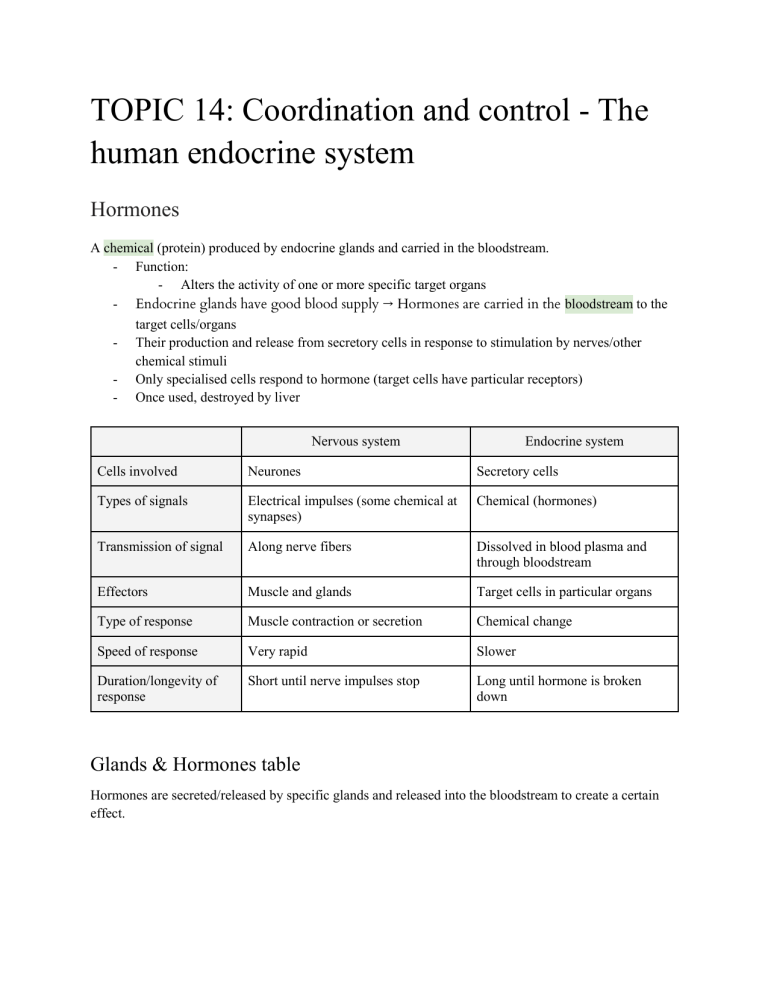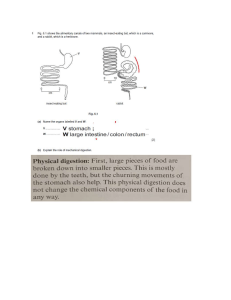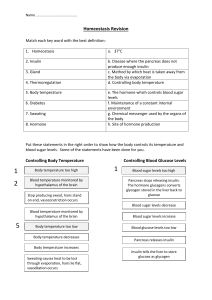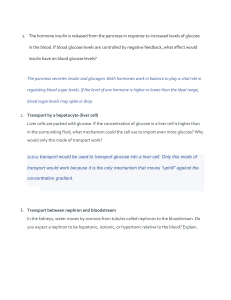
TOPIC 14: Coordination and control - The human endocrine system Hormones A chemical (protein) produced by endocrine glands and carried in the bloodstream. - Function: - Alters the activity of one or more specific target organs - Endocrine glands have good blood supply → Hormones are carried in the bloodstream to the target cells/organs - Their production and release from secretory cells in response to stimulation by nerves/other chemical stimuli - Only specialised cells respond to hormone (target cells have particular receptors) - Once used, destroyed by liver Nervous system Endocrine system Cells involved Neurones Secretory cells Types of signals Electrical impulses (some chemical at synapses) Chemical (hormones) Transmission of signal Along nerve fibers Dissolved in blood plasma and through bloodstream Effectors Muscle and glands Target cells in particular organs Type of response Muscle contraction or secretion Chemical change Speed of response Very rapid Slower Duration/longevity of response Short until nerve impulses stop Long until hormone is broken down Glands & Hormones table Hormones are secreted/released by specific glands and released into the bloodstream to create a certain effect. Hormone Source (gland) Target organ(s) Role Effects Oestrogen Ovary Reproductive organs Female sex hormone, controls menstrual cycle Develops female secondary characteristics (e.g. developed breasts, widened hips to prepare for pregnancy, growth of pubic hair) Progesterone Ovary Uterus Supports pregnancy Maintains uterus lining Testosterone Testis Reproductive organs Male sex hormone Develops male secondary characteristics (e.g. voice break, increased muscle, growth of pubic and facial hair) Primary: growth of testes and penis, increased sperm production Glucagon Pancreas (islets of Langerhans) 1) Liver Controls and balances blood glucose levels Increase blood glucose level by causing the liver cells to break down glycogen to glucose, and release it into the blood Insulin Pancreas (islets of Langerhans) 1) Muscle (respiration) 2) Liver (converted to glycogen) 3) MOST TISSUES Controls and balances blood glucose levels After eating, pancreas (islets of Langerhans) detects increase in blood glucose levels > pancreas secretes insulin into the blood > insulin 1) stimulates glucose to be stored as glycogen in the liver 2) stimulates glucose to be used in respiration Adrenaline Adrenal gland MOST TISSUES Stimulates “fight or flight” response Increases: - Heart rate - Speeds up conversion of glycogen to glucose > increased blood glucose levels > increased respiration in muscle cells - Breathing rate - Blood flow to muscles Decreases/reduces: - Blood flow to nonessential parts of the body (e.g. digestive system/alimentary canal) Other: - Dilates pupils to allow as much light as possible to reach the retina > more info can be sent to brain (T3) Triiodothyronine Thyroid gland MOST TISSUES Metabolism regulation (by stimulating the rate of metabolism) Affects growth and development (T4) Thyroxine Thyroid gland MOST TISSUES Metabolism regulation (by stimulating the rate of metabolism) Increases/decreases: - Heart rate - Metabolism rate (FSH) Folliclestimulating hormone Pituitary gland/Master gland 1) Ovaries 2) Testis Female sex hormone Matures egg cells and causes ovaries to produce oestrogen (GH) Growth hormone Pituitary gland/Master gland ALL TISSUES Maintains muscle/tissue growth Fuels growth during childhood (LH) Luteinizing hormone Pituitary gland/Master gland 1) Ovaries 2) Testis Female sex hormone Ovulation (stimulates eggs to be released) (TSH) Thyroidstimulating hormone Pituitary gland/Master gland Thyroid gland To stimulate TRH. Controls the production of thyroid hormones (T3 & T4) Stimulates the thyroid to release Thyroxine and Tri-iodothyronine (ADH) Antidiuretic hormone Pituitary gland/Master gland 1) Kidney tubules 2) Smooth muscle in arterioles Osmoregulation Increases permeability of the distal convoluted tube and collecting duct to water, allowing more water to be reabsorbed into blood Negative feedback systems in hormonal control Homeostatic control - Water concentration, temperature, blood glucose concentration, the control of thyroxine level Homeostasis - to keep the internal environment of an organism constant so that the body can work as efficiently as possible Negative feedback mechanism - The negative feedback control system responds when the condition changes, it returns it back to the ideal state (e.g. it reduces a rised level, vice versa) A continuous cycle of events Control of body temperature - - - - ● Keep a constant temperature (~37°C) helps enzymes to work at their optimum rate Endothermic - Endo- means within - Able to keep good control over own body temperature and keep it constant - Core body temperature is kept within narrow limits - Get heat energy from food, by respiration. - At colder temperatures, it is active with high body temperature to keep metabolising. At high temperatures, it is still active but less active to avoid heat stroke/overheating. - E.g. mammals, human, birds Ectothermic - Failed to keep its body temperature constant when the temperature of the environment changes - At 0°C, their metabolic rate slows down, their body temperature is also 0°C and they become inactive - At 20°C, the body temperature rises to near 20°C and becomes active Body temperature is controlled by hypothalamus in brain - It contains temperature receptors that sense the temperature of the blood running through it - It sends electrical impulses to skin to bring out actions to regulate body temperature Significance - Too hot: the body will sweat to reduce body temperature, to avoid heatstroke (which will denature the enzymes and alter metabolism) - Too cold: the body will shiver to raise body temperature, to avoid hypothermia (body temp. below 35°C) (which will make enzymes inactive) Structure of the skin (organ for temperature regulation) Epidermis (upper layer) ○ Cells undergo mitosis → new cells are made gradually move towards the surface of the skin As they go, they die → become keratin (a protein) Top layer (cornified layer) = dead cells ■ Hard and waterproof ■ Protects the living cells underneath ■ Always being worn away and replaced ■ E.g. soles of the feet ○ With cells containing melanin (brown pigment) which absorbs the harmful UV light from the sun ○ Hair follicles with hairs (made of keratin) Dermis (lower layer) ○ Made of connective tissue (with elastic fibres and collagen fibres) ○ Sweat glands: produce sweat (water + salts + urea), it travels through sweat duct to the surface of skin to lower body temperature through evaporation ○ Blood vessels and nerve endings (sensitive to touch, pain, pressure, temperature) ○ Adipose tissue (fat): to insulate the body against heat loss, energy reserve ○ ○ ● Structure of a section through human skin When temperature falls When temperature rises Shivering - Contract and relax very quickly to produce heat - The heat generated can warm the blood nearby, the blood helps distribute to other body parts Sweating - Sweat glands secrete sweat - Evaporation of water takes heat away (facilitate heat loss) Increase metabolism (to release more heat) e.g. respiration Might decrease metabolism (to avoid heatstroke) Hair stands up - Erector muscle contracts, pulling the hairs up - To trap a thick layer of warm air next to the skin, prevent heat loss - Acts as an insulator in hairy animals (not human) Hair lies flat - Erector muscle relaxes - Not to trap too much warm air Vasoconstriction - The arterioles near the skin surface are narrowed/constricted → allow little blood flow → reduce heat loss - The blood flows through shunt vessels (deeper) instead which has more insulation from fatty tissue Vasodilation - The arterioles near the skin surface are widened/dilated - More blood flow → more heat loss from the blood to the air How skin helps with temperature regulation Control of blood glucose concentration by pancreas and insulin Low blood glucose High blood glucose Glucagon released by pancreas Insulin released by pancreas Liver releases glucose into blood Body’s cells absorb glucose from blood Glycogen is converted into glucose (for higher blood glucose levels) Glucose is either USED or STORED (Glycogen) Glucose - simple sugar for cellular respiration Glycogen - stored sugar in liver and muscle cells Glucagon - HORMONE released from pancreas Type 1 & Type 2 diabetes Type 1 (insulin deficiency) Genetic diabetes, where the pancreas is genetically unable to produce enough insulin. - Causes: - Passed down from person to person genetically - Symptoms: - Treatment: CANNOT be cured, can be CONTROLLED - Inject insulin - the amount is determined by monitoring blood glucose levels frequently per day OR the amount of physical activity done per day - Careful dietary planning - Exercise Type 2 (insulin resistance) Diabetes obtained in life, where the cells in a person’s body are no longer able to respond to the insulin produced by the pancreas. - Common in elderly - Overweight/obese people have an increased risk of developing type 2 diabetes - Causes: - Poor diet control - intake too much food with high glycemic index - Lack of physical activity/exercise - Symptoms: - Treatment: CANNOT be cured, can be CONTROLLED - Inject insulin - the amount is determined by monitoring blood glucose levels frequently per day OR the amount of physical activity done per day - Careful dietary planning - Exercise



